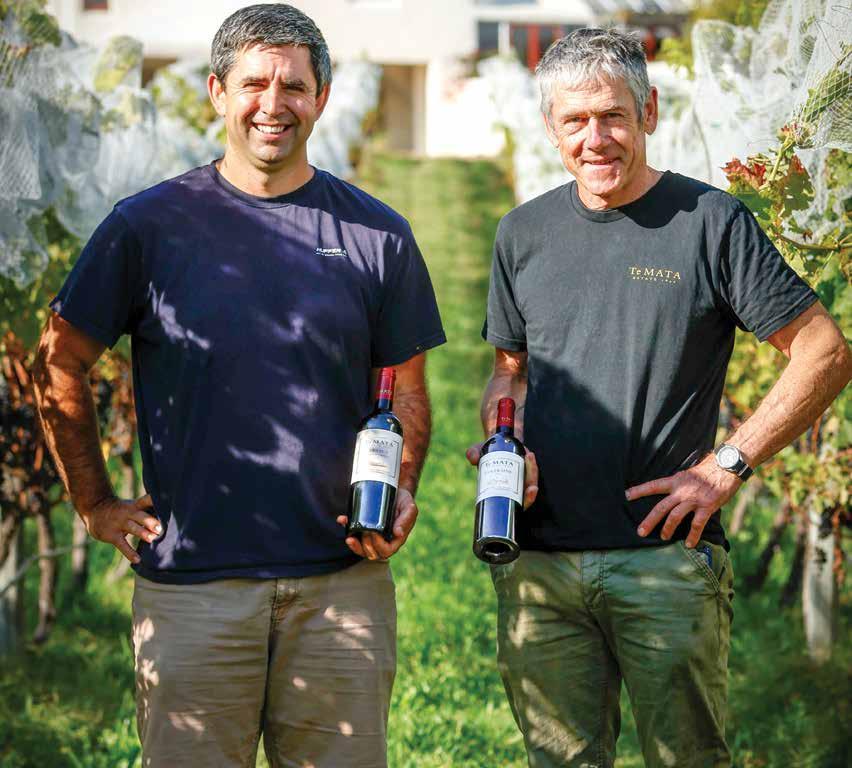








Te Mata is named after the nearby peak known in English as the `Sleeping Giant', such is its uncanny resemblance to a Brobdingnagian lying supine. There is nothing sleepy, however, at Te Mata, arguably New Zealand's finest producer of red wines. They burst onto the scene in 1909, scooping a Gold Medal at London's Imperial International Exhibition. By then, Te Mata was already New Zealand's largest producer, and now, a century later, their wines are still turning heads. All the fruit is sourced from their 220 ha of vineyards, although fully half is sold in bulk as it falls short of the Buck family's exacting standards.
The north-facing slopes of the eponymous peak are viticultural gold, with sandstone subsoils and free-draining clay that has an exceptionally high iron content. Hawke's Bay was the first delimited zone in NZ, largely due to the
quality of Te Mata. These wines alone warrant an Opimian membership; the balance, elegance and concentration, combined with remarkable purity of fruit, imbue them with icon status.
When one gets under the skin of New Zealand, it ceases to become a New World pretender and looks much more the seasoned wine destination. The Bay has been steadily coming up with the goods since 1870. It is a hallowed ground not just for Bordeaux varieties, but for Syrah, proving that Sauvignon Blanc does not always steal the limelight. Te Mata make a remarkable statement with Coleraine; (back cover) however, they go further, offering rare and generous insight into this region's affinity with a host of classic varieties.

LEARN MORE ABOUT TE MATA ESTATE
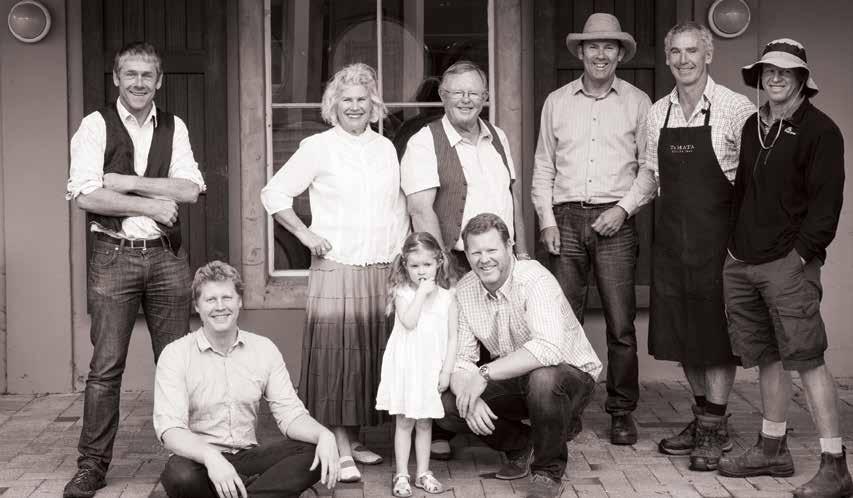


The advantage of Hawke's Bay Chardonnay is that it flies under the radar, offering reliable satisfaction in a region not shy on quality. Bang for buck considered, this stuff will top any list; a restrained style loaded with tantalizing glimpses of tropical fruit and oak that never overawe. Hawke's Bay is admittedly good at these, and, indeed, Chardonnay accounts for a fifth of all plantings. Pale lemon hue. Complex and beautifully fragrant nose, with toffee, red apple, peach, nectarine, cinnamon, pineapple juice and passionfruit. The palate rolls out a discreet red carpet for Chardonnay lovers, with its lemon, lime, apricot, apple, nectarine, coconut and cinnamon flavours, leading to a lingering finish with chiselled acidity. Unquestionably a real triumph at this price - lovers of classic white Burgundy take note! 2026-2031– mp

Dear Opimian Members,
Welcome to Cellar 330, an offering meticulously crafted to transport your palate across continents and through diverse terroirs. This edition is a testament to the incredible breadth and depth of the world of wine, bringing you classic elegance alongside vibrant innovation.
Gracing our cover and providing our featured wine is the illustrious Te Mata from New Zealand. A true pioneer and icon of New Zealand winemaking, Te Mata consistently sets benchmarks for quality and expression. Their wines embody the purity and vibrancy that have put New Zealand firmly on the global wine map.
Our journey begins in the heart of classic French winemaking. We delve into the nuanced elegance of Bourgogne, where Pinot Noir and Chardonnay reach their most refined expressions, speaking eloquently of their specific plots of land. From the crisp, mineral precision of Chablis, offering Chardonnay at its most refreshing, to the diverse landscapes of Pays d'Oc, where innovative winemakers craft accessible, fruit-driven wines with Mediterranean charm – France continues to offer a spectrum of delights.
Then, we venture south to the dynamic and exciting wine regions of Australia. Here, we celebrate the innovation and character found in every bottle. This Cellar features exceptional subscription cases from two Australian powerhouses: Wines by Geoff Hardy, known for their deep roots and diverse, high-quality offerings, and Thistledown Wine Company, celebrated for their focus on old vine Grenache and expressive, modern styles. These selections offer a consistent flow of Australian excellence directly to your cellar.
Understanding your desire for convenience and curated variety, Cellar 330 also presents three thoughtfully assembled mixed cases. These collections are designed to appeal to diverse palates and occasions, offering a fantastic way to explore the highlights of this Cellar without having to choose individual bottles. They are perfect for discovery, entertaining, or simply ensuring you always have a fantastic wine on hand.
At Opimian, our passion lies in connecting you with exclusive, high-quality wines and spirits, handselected by our Masters of Wine. Cellar 330 is a vivid demonstration of this commitment, offering a global tapestry of flavour and stories. We invite you to explore these pages, discover new favourites, and deepen your appreciation for the art of winemaking.
Cheers,
The Opimian Team

Let yourself be inspired by Opimian’s Masters of Wine. Our custom chart features a list of symbols to help guide your selection. Still unsure which wines to order? Contact us!
There are three ways to order. The last day to order for each Cellar Offering can be found listed on the cover. No orders will be processed after this time.
The wines featured on this Cellar Offering are still at the producers’ wineries when you order them, so it is normal that the process takes a bit of time and effort on our side.
Release dates are dependent upon actual arrival dates, distance from port of entry to liquor board and processing time required by each liquor board.
Once the wine arrives at your local liquor store or distribution centre, you will receive a Pick-up Notice with the specified date (the Release Date) and your pick-up location. Let us handle the rest.
British Columbia and Ontario members, your wine will be delivered to your door.

Andrew Jefford is Contributing Editor and columnist for Decanter and The World of Fine Wine, and Academic Advisor to the Wine Scholar Guild. He co-chairs the Decanter World Wine Awards and writes for The New Statesman. A prolific author and BBC broadcaster, his books include The New France, Whisky Island, and Drinking with the Valkyries.

Michael Palij MW is an adventurer, entrepreneur, and the 3rd Canadian Master of Wine. Over the years, he has introduced Opimian to some truly special producers such as Cabutto, Giovanna Tantini and Cantina Clavesana.
To kick off the 2026 season, we're thrilled to welcome. Andrew Jefford, who joins Michael Palij MW—two trusted experts helping you discover even more exceptional wines. Meet Andrew.
1. What attracted you to the world of wine?
When I was 16, I began making homemade wine (using grape-juice concentrate and “country” ingredients like carrots and elderflowers) to enliven family mealtime conversations. That got me interested in the fermentation process – and then, through reading, I discovered a vast and exciting world of differences and nuances. Right from the start, I loved wine’s combination of intellectual challenge and sensual reward, as well as its mood-altering abilities.
2. What excites you most about the current wine world?
Regionally speaking, I’m very interested in “the New Europe” – countries like Slovenia, Croatia, Romania, Moldova, and Georgia with ancient wine traditions but which suffered arrested development because of war, poverty, and politics over the last century. All are now flourishing again (to varying degrees: the first three are safely inside the EU, but Moldova and Georgia are still struggling with Russian interference), and we’re beginning to realise just how much they have to offer us. Trends? I’m really happy that texture is beginning to be taken seriously and valued as a wine quality. I love tannic reds and thick-textured whites. Stylistically speaking, I’m a big fan of orange or amber wines: a key medium of wine expression that we almost completely forgot.

3. Is there a region or grape variety you’re especially passionate about?
I live in France, so perhaps I should mention Madiran and Alsace, whose wines I love – thanks in large part to Tannat in the former region and Gewürztraminer in the latter.
4. What's your most memorable bottle?
Ch. Pichon-Lalande 1982. I bought a pre-arrival case (£9 a bottle delivered), and every bottle was magnificent: so tender, so ripe, so resonant. It came early in my drinking life, so I’ve never forgotten it. But I’m not saying (to anticipate your next question) that this was “the best bottle I’ve ever drunk.”
5. What’s a wine myth you'd love to debunk?
It’s the idea that excellence in wine is what matters. It isn’t. Difference is what matters; that’s where wine’s beauty and reward are to be found. Excellence is a subjective chimera. If I’d spent the last 40 years drinking only Pichon-Lalande `82, my drinking life would have been tedious. Many simpler wines are just as lovely, and just as memorable.
This is why I deplore the use of scores, though I accept that they are here to stay. They do, however, tell people that a 98-point wine is “better” than a 93-point wine. It isn’t. It’s just different. We should be exploring and enjoying the differences, not constructing a theology of excellence via point scoring.
6. What’s your go-to food and wine pairing?
I drink what’s open and eat what’s in the fridge, and mostly it works out (though we did have a bottle of the PichonLalande '82 with paella once, which was a flop). Food and wine combinations are something I don’t want to stress about.
But if you serve me a bottle of ripevintage Pomerol with cheese on toast (English vintage farmhouse cheddar on wholemeal toast, grilled until it’s bubbling and browning), I’m going to love it.
7. Favourite indulgent meal or snack?
Did I mention cheese on toast?
8. What’s one wine in your cellar you’re saving for a special occasion?
I visited Dominus shortly after Christian and Cherise Moueix and their team had bottled the 2013, and they gave me a half-bottle. I love Napa, and thought that wine was wonderful. I’m only ever going to have that half, and it’s the vintage with his portrait on the label (for the 30th anniversary). That’s for a special occasion.
9. Favourite film or TV series to relax with a glass of wine?
The Godfather – ideally with an old bottle of Regaleali’s Rosso del Conte. The first wine trip I ever did as a journalist was to visit Regaleali in Sicily in the late 1980s. I asked Conte Giuseppe Tasca d’Almerita if I could photograph him. He went upstairs for a while, and came down fully armed, wearing a bandolier (maybe two). That was what happened, and when I think about Sicily, that’s what comes to mind.
10. What’s one thing people might be surprised to learn about you?
That’s a tricky one, since I’m an obscure and unimportant person, so everything and nothing will be surprising. I do, though, revere owls, nightjars, swifts, and storm petrels. Will that do?

OUR WINE EXPERT'S FAVOURITE WINES IN THIS CELLAR


ANDREW'S COUPS DE COEUR
PETIT CHABLIS, AOC, 2024, LOT 5791, P26


MICHAEL'S COUPS DE COEUR
DEPERNON FRÈRE ET SŒUR, AOP MARANGES 1ER CRU "LES CLOS ROUSSOT", 2023, LOT 5810, P21
K1 BY GEOFF HARDY GRÜNER VELTLINER KUITPO SINGLE VINEYARD, ADELAIDE HILLS, 2024, LOT 5774, P15


TE MATA ESTATE SYRAH, HAWKE'S BAY, 2024, LOT 5763, P8
5761


5763
Bright, zingy and zesty with a focused nose delivering classy Kiwi 'Savvy' notes of cut grass, gooseberry, asparagus and lime juice. The palate is equally frisky, fresh-cut orange, grapefruit, passion fruit, gooseberry and lemon zest taking hold. The finish romps home with a spring in its step, showing a lovely melange of citrus and vegetal notes. 2026-2028 – mp
Deep purple hue. An intriguing combination of sweet currant and plum, with some of the smoky bacon notes more reminiscent of Northern Rhone Syrah. There's a big drench of dark blackcurrant at the core of this fresh and lively wine. Vivacious acidity provides the balance, while the tannins are very discreet, and the subtle smoke on the finish has considerable appeal. 2026-2030 –aj



TE MATA ESTATE AWATEA CABERNETS/MERLOT, HAWKE'S BAY, 2023
Cabernet Sauvignon, Merlot, Cabernet Franc
$ 67 $ 402

TE MATA ESTATE IS NEW ZEALAND’S OLDEST CONTINUOUSLY OPERATING FAMILY-OWNED WINERY.
$ 90 $ 540
Medium garnet hue. Pure, subtle aromas of hedgerow, strawberry, raspberry, cherry, woodsmoke, rhubarb, thyme and blackberry. This unfolds gracefully on the palate, with layers of perfectly ripe Pinot fruit including cherry, raspberry jam, damp earth and rhubarb entwined in silky tannins. The finish is long and packed with a myriad of flavour. A superb example. 2026-2035 – mp
Charcoal-roasted eggplant with lamb kofta and tahini yogurt
Medium purple hue. My goodness, but this is an impressive glass of wine! Complex, assured nose of blackcurrant, cassis, vanilla, tobacco, cigar ash, cedar, cinnamon, clove, plum, dark cherry, and dried blueberry. Deserving of a place in anyone's cellar at this price, showing a gorgeous palate redolent of oak and black fruit but with huge complexity encompassing black cherry, blackcurrant, blackberry, tobacco, cocoa powder, vanilla, clove, cedar, charred wood and gun smoke. Quite astonishing! 2029-2035 – mp
Miso-glazed sablefish (black cod) with shiitake mushrooms
A metamorphosis from trader to wine creator changed Master of Wine Giles Cooke’s life. The Thistledown founder is now not merely a wine producer in some of South Australia’s key wine-growing locations, but a campaigner, too, championing Grenache as “Australia’s
signature variety”. He fights for old-vine fruit from the best growers, then picks it (as he puts it) “on the way up”: as it approaches its ripening apogee; natural wild-yeast ferments in concrete eggs are a key part of his non-interventionist winery philosophy, crafting wines with “a lithe energy and silky texture”. That same approach -- maximum respect for the raw materials to maximize pleasure and intrigue for the drinker –characterizes his work with other varieties, too, like Cabernet, Shiraz and Riesling.
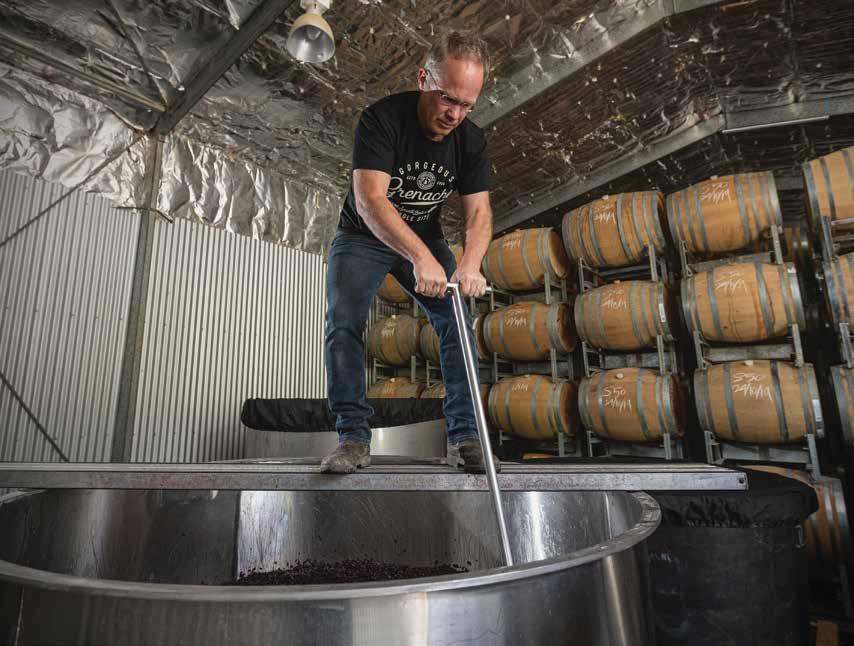


5767
BY THISTLEDOWN THE OPPORTUNIST SHIRAZ, SOUTH AUSTRALIA, 2023
Shiraz
5768
BY THISTLEDOWN THE COURTESAN RIESLING, CLARE VALLEY, 2023
Riesling

Deep purple hue. Softly expressed scents of warm raspberry and blackberry. Instantly harmonious and enticing, with oaking subtle and seamless. Smooth, svelte and curranty on the palate, there is a core of blackcurrant acidity to freshen the wine and keep it lively. The black pastille fruit is attractive, and there is poise and shapeliness. 2026-2029 – aj

Pale lemon hue. Intense nose of lime leaf, lime zest, lemon curd, acacia, bay leaf, and passion fruit. Sunny, exciting example of Clare Valley Riesling, with layers of citrus fruit underpinned by freshness and balanced alcohol. Bursts with lemon, lime, grapefruit and floral notes on a lingering finish unadorned by oak.
2026-2028 – mp
5769
BY THISTLEDOWN THE PUGILIST CABERNET SAUVIGNON, SOUTH AUSTRALIA, 2023
Cabernet Sauvignon

Dark and dense. This is a very minty expression of Cabernet. There is eucalyptus, black pepper, cassis, blackcurrant and lots (and lots) of mint! A userfriendly style with luscious, jammy fruit complemented by fresher capsicum notes, rose petal and tea leaf. The finish is generous and ripe, with haunting aromatics. 2027-2030 – mp
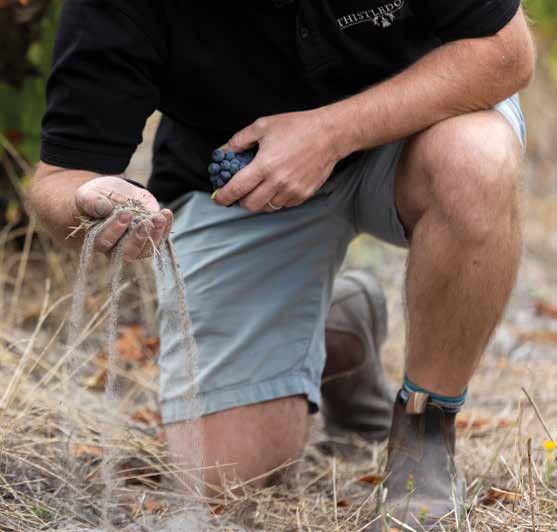

5771
THISTLEDOWN THE VAGABOND OLD VINE GRENACHE, BLEWITT SPRINGS, MCLAREN VALE, 2024
Grenache Noir
Poised plum and pomegranate fruit plus a little rosehip complexity in graceful, serene, almost floating style. Soft, open and inviting flavours of ripe, affable red fruits, with a gracefully perfumed edge. There are light tannins, but it's the strawberry acidity that assures the wine's balance, leaving the mouth clean. 2026-2029–aj
5770
THISTLEDOWN OUR FATHERS THERE IS A LIGHT SHIRAZ GRENACHE, MCLAREN VALE, 2024
Shiraz, Grenache Noir NEW
Deep, soft plum and bramble fruits, full of ample, unfussy ripeness. Some smoky depths, though it is the fruit that really sings out at this stage. Generously constituted, and, despite the colour, a smooth texture. Acidity plays the main structuring role, unencumbered by tannin. 2026-2029–aj

By Jacky Blisson MW

Is this bottle ready to drink, or should I wait a few more years? For many wine lovers, especially those with growing collections, the question of when to pull the cork can be a source of constant second guessing. We want to experience our favourite wines at their “peak” but defining that ideal moment is far from simple. When does a wine truly shine? And how do you know if it’s best enjoyed now or tucked away for the future?
The idea of deliberately ageing wine, rather than simply storing excess bottles, is a relatively recent phenomenon. According to wine historian Rod Phillips, before the 1800s, wines were generally unstable and risky to store. It wasn’t until the early to mid 20th century that cellaring became commonplace among wine merchants and dedicated amateurs alike. By the 1970s, mainstream wine publications were offering detailed vintage charts and cellar recommendations, fuelling the belief that wines from classic regions like Bordeaux, Barolo, and Burgundy required years of patience. Collectors would scour restaurant wine lists for older vintages and squirrel away cases, waiting for that fabled sweet spot when the wine would transcend its youthful sharpness and reach new heights.
But what actually happens to wine as it ages? In its youth, a wine’s aromas are dominated by what are called “primary” characteristics—notes that come directly from the grape itself, like fresh fruit, flowers, or herbs. Over time, as minute amounts of oxygen seep into the bottle, these fade and are gradually replaced by “tertiary” aromas. Depending on the grape and style, these might include dried fruit, mushroom, earthy or leafy notes, leather, or nutty nuances. Red wine tannins also soften with age, giving a smoother, rounder texture. And if the wine was aged in oak, those wood-derived flavours, like vanilla, cedar, or spice, often become more integrated and harmonious.
Despite the romantic appeal of aged wine, not every bottle is destined for long-term cellaring. Many wines on the market today are crafted specifically for early enjoyment. Fresh, fruity styles like most rosés, unoaked white wines, and simple reds are made using techniques that prioritise immediate drinkability—

cool fermentation, stainless steel tanks, quick bottling, and so on. Entry-priced varietally labeled wines, basic Côtes du Rhône, simpler Chianti wines are all examples of wines that are usually at their best within a few years of release.
The same goes for many natural wines. While there are age-worthy exceptions, a large number of low-intervention wines, made without added sulphites, are more vulnerable to oxidation and spoilage. Without stable, cool, dark, and humid storage conditions—which most people don’t have at home— these wines are often better enjoyed young.
Even wines once considered hard-edged in their youth have become more approachable earlier. Changes in viticulture and winemaking, like gentler pressing, whole-bunch fermentation, and reduced use of new oak, have softened the edges of many traditionally cellared wines. Today’s red Burgundy, for instance, can offer a lot of pleasure just a few years after bottling, without the need for a decade of patience.
Others Reward the Patient Drinker
That said, there are still many wines that benefit enormously from ageing. Wines with firm acidity, high-quality tannins, and concentrated flavours can evolve beautifully over time. Think dry Riesling from Germany or Austria, top Chenin Blanc from the Loire Valley, structured reds from Bordeaux or Piedmont, and fortified wines like vintage Port or Madeira. How long to cellar depends on the grape variety, the vintage, and your personal taste. If you’re simply looking for a big red to soften and mellow a bit, six to eight years might be enough. If you’re drawn to complex, savoury, aged character, a wait of 15 years or more might be in order.
In the end, deciding whether to drink or cellar a wine is highly personal. It depends on the style you prefer, the types of wines you buy, and whether you have suitable storage conditions. Most importantly, it should be fun, not stressful. If you’re unsure, try buying multiple bottles of a favourite wine and opening one every year or two. That way, you can track its development and decide when it hits your sweet spot. And remember, far better to open a bottle a little early and enjoy its fresh vibrancy than to wait too long and find its peak has come and gone.
Thomas Hardy, whose ship left Devon for South Australia in 1850, became the young state’s most successful winemaking pioneer. That spirit lives on in his great-great-grandson Geoff. K1 refers to the Kuitpo vineyard in the Adelaide Hills –lonely pastureland where Geoff planted every vine himself, to widespread scepticism. Geoff’s initials (GMH) mark varietals and blends made from fruit which Geoff and prizewinning winemaker Shane Harris feel meet their criteria: value and character, approachability with refinement.


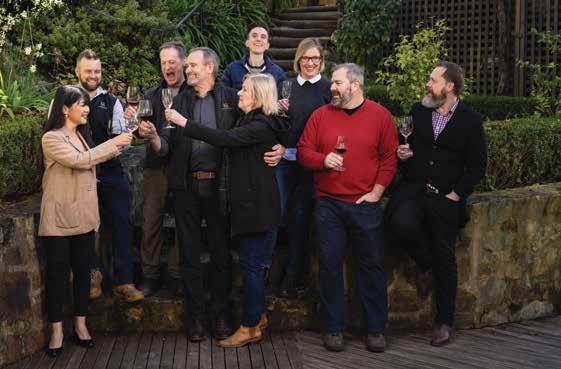
5775 GMH SHIRAZ, SOUTH AUSTRALIA, 2024
5776 GMH MERITAGE, SOUTH AUSTRALIA, 2024

Deep purple hue. Plenty going on the nose, with notes of crushed black pepper, griottes, camphor, liquorice, dried blueberry, black cherry and dried leaves. This is a fat, soft style of Shiraz, its cascading ripe fruits balanced by searching curranty acidity. The tannins are light, and it finishes tarry. 2027-2030 – mp

Deep purple hue. Sweet, minty oak dominates the aromas at this stage, but there are finely composed blackcurrant and black cherry fruits behind. Juicy and lively, with ample wealth of tongue-coating black fruits. The structure in this wine comes from these almost explosive fruits and the lively, singing acidity which detonates from them. There are soft, dark tannins to lend support, but the texture remains smooth and accessible, never insisting on ageing. Blackcurrant power, right to the last drop.
2026-2030 –aj
blackcurrant, cedar,
Dolcetto, Petit Verdot, Shiraz

Deep, dense red hue. There's plenty of oak evident on the nose of this intriguing blend, sweetening what are intrinsically spicy, lively fruits (both red and black).
Full-bore and vivid, with ample black- and redcurrant fruits, plus some raspberry. Bright acidity illuminates and sustains the wine through to its pungent finish, where the aromas echo in the mouth.
Lightly textured and bright to the end. 2026-2031– aj
Blackcurrant, redcurrant, raspberry, vanilla
Grilled eggplant rollatini with ricotta and tomato confit

Saturated midnight black. Powerful blackcurrant and black cherry fruits dominate the nose, with vanillafragrant oak and a sappy plant freshness filling the back canvas. Soft, deep and vivid, revealing intense blackcurrant and sloe fruits, vibrant, insistent acidity, and a grind of black pepper. Acidity levels give the wine significant concentration and drive, but the fruit can sustain this, and there are soft tannins to bring some bass structure. 2026-2030 – aj
black cherry, vanilla, blackcurrant leaf
Sloe fruits, cassis, black pepper
Herb-crusted venison medallions with blackberry jus

Deep purple hue. Accomplished, complex nose showing blackberry, blackcurrant, eucalyptus, mint, vanilla, cedar and cassis. This is huge, obvious and generous, showcasing the best of Adelaide Hills Cabernet (an area known for very elegant reds). The palate offers mint, cassis, mineral oil, peonies, dark chocolate, bramble, vanilla, clove and wood smoke. The ensemble is concentrated, balanced, and very, very long. 2027-2030 – mp

5774
K1 BY GEOFF HARDY GRÜNER VELTLINER KUITPO SINGLE VINEYARD, ADELAIDE HILLS, 2024
Grüner Veltliner
Medium lemon hue. Pronounced, complex nose with oodles of personality, showing wet wool, candle wax, mandarin orange, greengage and banana. This has a brilliant palate with gorgeous texture and intriguing mix of flavours, including jasmine, gooseberry, white peach, lemon, grapefruit, tangerine and white pepper. It's a kind of Chenin-Albariño cross, and a true Ozzie original. 2026-2028 – mp


The cherry and cherry-blossom aromatics here are almost as appealing as the wine's petal-pink colour: tender, understated and inviting, as all good rosé should be. Smooth, fresh and poised, with subtle cherry and plum fruits, and enough structure and sinew to accompany dishes well. Unusual Provençal finesse for its Oc origins. 2026-2027– aj

Pale lemon hue. Brisk acidity is the first thing one notices on this charming and inexpensive cool-climate Chardonnay. The nose offers delicate hints of acacia, wisteria, blossom, green apple and lemon. The palate is much the same, with a filigree finish of lemon, lime, green apple, plus floral notes of wisteria, hawthorn and acacia. A very drinkable cool-climate Chardonnay. 2026-2028 – mp

Pale lemon hue. Lovely aromas of gooseberry, asparagus, lemon pith and lime zest. This punches well above its weight on the palate and is destined to become an Opimian favourite! Perfectly balanced, with bright acidity and notes of asparagus, gooseberry, cut grass, grapefruit and lemon zest. The finish is brilliant, all clearly defined citrus and grassy notes. A joy. 2026-2028 – mp
5784 FAMILLE LAMBLIN PINOT NOIR, IGP PAYS D'OC, 2024
5785
WINES TO SAVOUR ANY DAY OF THE WEEK
FAMILLE LAMBLIN MERLOTCABERNET, IGP PAYS D'OC, 2024

Medium ruby hue. Burry, soft-focus warm currant and bramble. This is a gentle, very welcoming mouthful brimming with ripeness, giving the fruit more resonance and persistence than you'd expect from a Pinot at this price. Traditionally-styled but packed with the reassuring, comforting virtues of soft, affable fruits. 2026-2029–aj
Pale purple hue. Lots of vibrant red-fruit freshness and clarity on the nose. Zesty, with some savoury notes, too, reflecting its southern origins. On the palate, this packs in a huge amount for its price. It is juicy, tangy and exuberant, with a wild thyme edge, and there is a cleansing bitter edge on the finish. Languedoc in a glass: who says you can't have terroir in entry-level wines? 2026-2028 –aj

Situated on the western outskirts of Macon, at Prissé, Pierre des Dames is the work of local hero Vincent Nectoux, who moonlights as President of the Saint-Véran cru. Unsurprisingly, he is well respected locally for his Chardonnay, although he is no amateur with Pinot Noir, either. Pinot in this neck of the woods often plays second fiddle to Chardonnay but this is full of both fruity simplicity and earthy, Burgundian vigour. Like many, he is a keen advocate of sustainable viticulture: Pierre des Dames is certified ‘High Environmental Value’ – a government-led initiative that gathered pace in Bordeaux but which Burgundy is happy to adopt, given that the region aims to become carbon neutral by 2035. Classic smallholder stuff that takes you straight to the breadbasket of France.


$ 39 $ 234
Pale ruby hue. An earthy, rustic style of Pinot, this will appeal to those wanting an Old Skool example. On the nose, one finds forest floor, tobacco, wet leaves and mushroom, supported by red fruit including strawberry and cherry. There's a healthy lick of tobacco and forest floor on the palate, that joins tinned strawberry and strawberry jam to create an inviting, straight-forward Pinot that revels in its simplicity. 2026-2028 – mp

5799
DOMAINE DESERTAUX-FERRAND, BOURGOGNE BLANC, AOP, 2024
Pinot Blanc, Chardonnay

Pale lemon hue. Almond, hazelnut, white flesh nectarine, sour cream, dried honey, pink grapefruit and coconut make for an inviting nose. On the palate, a hint of oak provides attractive complexity and notes of toffee, coconut and butter allied to ripe stone fruit including peach, apricot, quince and red apple. Very long finish that demonstrates a capacity to age – worth the money! 2026-2030 – mp
5800
DOMAINE DESERTAUX-FERRAND, CÔTE DE NUITS-VILLAGES, BLANC, AOP, 2024
Chardonnay, Pinot Blanc

Medium lemon hue. Charming, welcoming and big-hearted, this rich, ripe white Burgundy delivers oodles of complexity, with a pronounced nose showing vanilla, coconut, nutmeg, red apple, quince, honey, wet stone, butter, and yellow peach. In the mouth, oaky notes including vanilla, coconut and butter are allied to nutty notes of cashew and almond, together with lashings of stone fruit, including peach, apricot, apple and pear. The finish is predictably long, with punchy acidity providing focus. Difficult to resist! 2026-2030 – mp
5801
A family affair since 1899, Desertaux-Ferrand is based just south of Nuits-Saint-Georges. Eminent desirability aside, there was a time when even this stretch of Burgundy was unwanted. The post-war years were especially tough, and the 1950s saw a string of miserable vintages, although come the 1960s, momentum swung in proprietor Bernard Desertaux’s favour. Incredibly, he had only Pinot Blanc at his disposal, so planted Chardonnay and built a reputation based on his whites; Les Perrières (Pinot Noir) was first bottled in 1985.
Bernard’s children Christine, Vincent, and Vincent’s wife Geneviève, have managed the domaine since the 1990s. Every year these wines genuinely excite the panel with textbook Burgundian complexity and weight without the fairy dust price tags that so many wines from this region command.
DOMAINE DESERTAUX-FERRAND, CÔTE DE NUITS-VILLAGES LES PERRIÈRES, AOP, 2023
Pinot Noir

Medium purple hue. Precise, focused nose, with oak influence including vanilla, woodsmoke and clove supporting black fruit including cherry, plum and berry. In the mouth, this dramatic, fleshy red is a delight. The palate marries firm tannins and high acidity with a wealth of predominantly black fruits, including cherry, plum and berry. Oak adds nuances of cedar and vanilla, and together these drive a long and complex finish. Top-tier CdN Villages. 2026-2030 – mp
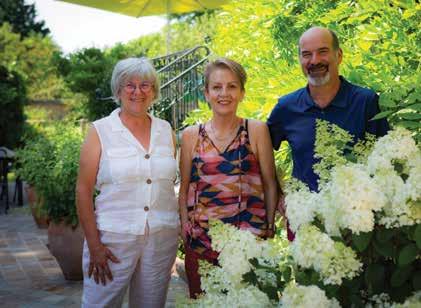
5804

TANGUY CHEVALIER, AOP COTEAUX BOURGUIGNONS ROUGE, 2023 Gamay
Medium ruby hue. The nose offers vegetal notes of tomato leaf and bell pepper allied to black cherry, black plum and raspberry compote. Compact and nervy in the mouth, this delivers a core of ripe red fruit including strawberry, cherry and plum. The tannins are firm, working well alongside the crisp acidity and concentrated fruit. Less showy and obvious than many Beaujolais, this is an elegantly spun Gamay for purists. 2026-2028–mp
Burgundy is changing. We all love the grand village names, but you need a grand budget to keep up with them today. There are, though, new alternatives for Burgundy lovers. Maranges (a trio of villages just to the south of Santenay) has been offering Côte d’Or value since 1989. Ever-warmer vintages make the Hautes Côtes – the rumpled hills to the west of the Côte d’Or – increasingly appealing for fine-grained Pinot and Chardonnay. Coteaux Bourgignons (created in 2011) and the old-established Côte de Nuits-Villages, meanwhile, are both great ways to bring the fruit of exciting ‘forgotten parcels’ of vineyard to market.

Strawberry, red cherry, red plum
Duck confit shepherd’s pie with celeriac mash
5805
DOMAINE GOUBARD BOURGOGNE CÔTE CHALONNAISE, MONT-AVRIL, AOP, 20% FÛT DE CHÊNE, 2024
5806
DOMAINE BONNARDOT BOURGOGNE HAUTES-CÔTES DE NUITS, "L'ÂGE MÛRE", AOP, 2024
Noir

Medium purple hue. On first approach, this is generous albeit still closed, showing beetroot, rhubarb, strawberry, plum and cherry. On the palate, a classic Pinot with crunchy acidity, firm tannins and a wealth of red fruit including redcurrant, strawberry, raspberry and cherry. The finish is lingering, driven by a textbook blend of structure and fruit. Stunning value from this little-known appellation. 2026-2028 – mp

Light red hue. Scents of raspberry liqueur with some sweet leather behind. Pure and attractive, this has an impressive intensity of fruit for the Hautes Côtes, with firm tannic support. Roughcut plums come tumbling from the palate, and there is a smoky, savoury note, though it remains fundamentally a midweight. 2026-2029 –aj
Redcurrant,
Porcini
Rough-cut plums, woodsmoke, beetroot
Pan-seared Cornish hen with thyme jus and roasted forest mushrooms
5807
DOMAINE BONNARDOT CÔTE DE NUITS-VILLAGES, AOP, 2024
Noir
Ripe capsicum, raisin, cooked cherry
Black cherry, baked plum, tobacco
Roasted guinea fowl with thyme and wild mushrooms

Medium ruby hue. Ample sweet allure with ripe vegetal notes and a touch of raisiny sweetness. Soft and fruity on the palate, combining bright black cherry and plum. There's a raisin note again, just as the nose indicated, counterbalanced by plenty of freshness. Exuberant and easy to enjoy. 2026-2029–aj
5809
DEPERNON FRÈRE ET SŒUR, AOP MARANGES, ROUGE, 2024
Noir
Black truffle, plum, rhubarb, sweet spice
Clove, cedar, raspberry, cherry
Pork tenderloin with cranberry-port glaze and root vegetable hash

Dense, close-grained and enticing aromas of truffled fruits including raspberry, plum and cherry. Expansive and robustly structured, this energetic Maranges blends incisive raspberry fruits with ample smoky, earthy depths. Ripe, warm and long, with a firm finish that suggests it still has more to give with cellar time. 2027-2030 –aj
5810

DEPERNON FRÈRE ET SŒUR, AOP MARANGES 1ER CRU "LES CLOS ROUSSOT", 2023
Pinot Noir NEW
Sweet, leafy and fragrant, with wellintegrated oak notes of undergrowth, acorn and oak copse. Already showing attractive maturity, this still has much more to give. There is terrific wealth of flavour and texture on the generous palate, with its layers of black fruit, soft tannin, and smoky-savoury richness dominating the long finish and its gently subsiding tannins. 2027-2032–aj
Undergrowth, acorn, oak copse, coconut
Black plum, black cherry, woodsmoke, clove
Beef tenderloin with black garlic purée and red wine reduction

Nicolas Thevenot’s domaine is sited in one of the most planted villages of the entire Haute Côtes, Marey-lèsFussey, well-known for its splendid Thevenot-family monopole of Clos du Vignon, dating back to the 12th century. The 30-ha (74-acre) of Thevenot vines are all sited between 320m and 450m (1,050 feet and 1,476 feet): this increasingly sought-after altitude gives them remarkable freshness, poise and aerial purity of flavour.
TERROIR INTEGRITY IS THE FOUNDATION OF WINEMAKING AT DOMAINE THÉVENOTLE BRUN.


5811
DOMAINE THEVENOT-LE BRUN BOURGOGNE HAUTES CÔTES DE BEAUNE, BLANC, AOP, 2024
Restrained aromas of honeysuckle blossom, green malt and spring beech leaf. Lively and graceful Macon in slender, contemporary style, leaving the mouth refreshed and longing for more. Lots of green apple and lemon here in the searching but simultaneously refreshing palate, leading to a crisply defined, almost stony finish. Macon for Chablis lovers! 2026-2028 –aj
5812
DOMAINE THEVENOT-LE BRUN BOURGOGNE HAUTES CÔTES DE NUITS, ROUGE, "CLOS DU VIGNON", MONOPOLE, AOP, 2024
Pinot Noir
Pale ruby hue. Still in its infancy but showing encouraging notes of redcurrant, strawberry jam, raspberry and mulberry. There is a huge whack of tannins allied to sweet red fruit including red cherry, plum and redcurrant on the palate. The oak adds cinnamon, clove and vanilla. Give this time, and it will certainly deliver. 2026-2028 – mp
12%
Beef bourguignon tartlet with caramelized shallot glaze

DOMAINE THEVENOT-LE BRUN BOURGOGNE HAUTES CÔTES DE NUITS, ROUGE CASE - 3 BOTTLES EACH: 2023, 2024
$ 60 $ 360
2023 was a very successful vintage across Burgundy, with stable, warm temperatures throughout the year and a plateau after mid-July that allowed for plenty of freshness and even ripening. Indicative of the vintage, Thevenot-Le Brun’s 2023 is classically proportioned and worthy of a place in the cellar.
These wines are the result of diligent poking around in Burgundy’s hinterland and members should take advantage of the great value on offer. By contrast, 2024 was more challenging with both frost and high humidity (read disease pressure) tinkering unhelpfully with the final product. This said, Clos du Vignon is a sizable, seven hectares of chalky, rocky soil that provides an ideal backdrop for challenging vintages. Whilst both these wines will benefit from cellaring, the smart money is on cracking the 2024 first and giving it a good decant to smooth out the edges. The 2023 will sleep gently for a few more years.

DOMAINE THEVENOT-LE BRUN BOURGOGNE HAUTES CÔTES DE NUITS, ROUGE, AOP, 2023
Appealing nose offering both purity and elegance, with black cherry, lavender, bay, thyme, vanilla, cedar, incense and plum jam aromas. This has the hallmarks of the fine 2023 vintage with its depth and precision. There is a broad swathe of red fruit, including cherry and plum alongside liquorice, tobacco and cedar. Seamlessly integrated finish, with fine tannins and plenty of oomph. 2026-2031– mp
13%
DOMAINE THEVENOT-LE BRUN BOURGOGNE HAUTES CÔTES DE NUITS, ROUGE, AOP, 2024
Bright, fresh, beguilingly sweet strawberry and plum dominate the aromatic profile, with discreet floral notes in behind. In the mouth, there's some vanilla-infused tobacco wealth and a little sweet semolina cereal grain in the mid-palate. The finish is sustained and seamless. 2026-29–aj
12%
Strawberry, sweet plum, florals, winter spices
Cranberry, vanilla, tobacco, semolina
Roasted quail with fig compote and polenta cake
The power of family transmission is strong in isolated yet world-renowned Chablis. The name is synonymous with mouth-watering, tongue-tingling white wine, impossible to duplicate elsewhere. If you have landholdings or business interests in its 5,866 ha (14,495 acres), they’re an enduring asset, not to be squandered. Even so, few Chablis dynasties can match Lamblin for longevity (the family has worked in the region since 1690), nor for the commercial skill involved in bringing the best of Chablis to the world. In recent years, the family has made typically canny, well-judged selections up and down Greater Burgundy and now into the Rhône and Languedoc, too. The sure-handed classicism of Clément’s palate combined with Alexandre’s evident administrative skills (the pair constitute the 12th generation) lie behind this expansion, making Lamblin a benchmark for both diversity and appellation fidelity.




Pale lemon hue. Bright, punchy Chablis with authority and breadth to it; long and lean yet tautly ripe. The nose gives a lot, especially with a few minutes in the glass: a mist of pungent yet ripe orchard fruits. The mid-palate length is sustained, with plenty of sinew and drive. Ample purity and wealth of fruit remains on the stony, crushed-kernel finish. 2026-2029–aj





Pinot Noir, Chardonnay
Pale salmon hue. Fresh, simple and attractive nose of strawberry, red apple, redcurrant and cherry. This has an appealing roundness of fruit that cleverly looks like residual sugar but isn't! Perfect on a hot summer's day, the palate shows tinned strawberry, raspberry compote, and a juicy finish, with a judicious lick of acidity to balance. 2026-2028 –mp
5789 SAINT-BRIS SAUVIGNON, AOC, 2024
Sauvignon Blanc
Cured Arctic char blini with crème fraîche and dill 13.5%

5790 BOURGOGNE ALIGOTÉ, AOC, 2024
Pale lemon hue. Very satisfying, appetising Sauvignon aromas, with little green grass or leafiness but plenty of classical Burgundian wealth and sap. An attractive, percussive stoniness is what you notice first on the palate, followed by the drive and sinew of its origins. Only then do you get a peep of the green leaf typical of the variety … and it's just a peep. Truly a Sauvignon for Burgundylovers. 2026-2028 –aj
Pale lemon hue. A well-rounded and approachable Aligoté full of soft appleorchard fruit. Vital and fresh on the palate (despite the sense of roundness on the nose), this is a classic Yonne Aligoté charming in its restraint and purity. There is some attractive salinity, too, to add to the quenching appeal. 2026-2028 –aj
5791 PETIT CHABLIS, AOC, 2024
Chardonnay
Pale lemon hue. A prettily scented, high-impact Petit Chablis with all of the cool limestone pungency and juicy acid resonance you would look for in its pricier siblings. The bright, crisp flavours combine a fresh leafiness with ample, pungent wet stone. It leaves the mouth fresh and tingling. The finish is pure, long and reverberative, with more length, too, than you'd normally expect from a Petit Chablis. Hard to stop drinking this one. 2026-2029–aj

5792 CHABLIS, VIEILLES VIGNES, AOC, 2024
Chardonnay

This 'old vines' incarnation brings the drinker a rounder style of Chablis than many of its peers. There is impressive apple, lemon, and even Seville-orange acidity, and there's some driedcitrus sweetness to fill that acidity out and bring further resonance. The wine finishes rich and searching -- yet look out for classic crushed stone notes returning on the finish. 2026-2029 –aj
Crushed stone, ginger, hazelnut, sour cream, [0.80]
Butter-poached halibut with leek fondue
5793 BOURGOGNE PASSETOUTGRAINS, AOC, 2023
Gamay, Pinot Noir

Pale ruby hue. Bright, fresh and exuberant, with crisply defined strawberry and red plum fruit. The palate is intense, with dramatic but fruit-bonded acidity and tautly defined plum, strawberry and raspberry providing an exciting mouthful. Finishes energetic, zesty and pungent. 2026-2030 –aj
Raspberry, pomegranate, forest floor
Chicken and mushroom vol-au-vent with fine herbs

Medium garnet hue. Sturdy plum fruits with some dessert-apple exuberance behind. Smooth, tender and accessible, with spadefuls of enticing plum made all the more enticing by the fruit's cotton-soft textures. Grand harmony already: a plainly delicious, lip-licking Nuits that won't keep anyone waiting. 2026-2029–aj
Wellington-style beef tenderloin with mushroom


Spicy aromas of cinnamon and liquorice alongside tinned strawberry, raspberry and black cherry. A seriously accomplished southern French red with just about everything anyone could want at this price. There is a pronounced, juicy core of scented red fruit, including cranberry, red cherry, plum, and additional complexity brough by a warming, spicy note. Just what Dr. Cold Winter Night ordered! 2026-2028 – mp
Cranberry, red cherry, plum, spices
Grilled merguez sausage with harissa yogurt and warm chickpea salad
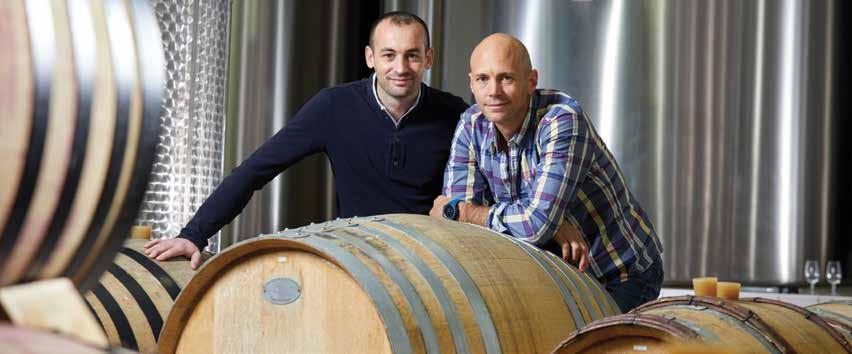
5796
CHABLIS PREMIER CRU MEDAL WINNING CASE - 2 BOTTLES
EACH: VAILLON, FOURCHAUME, BEAUROY (WOOD CASE)
$ 100 $ 600
There are seventeen areas under the banner ‘Chablis Premier Cru’, accounting for roughly a quarter of the appellation’s production. Vaillon, on the opposite side of the Serein River to the Grand Cru nucleus, is a real classic, with its southwest-facing aspect catching plenty of sunshine and offering early drinkability (even if the wines retain a certain satisfying briskness). Beauroy lies immediately north, overlooking the village of Poinchy, on an amphora-shaped spur notable for its distinctive flat top; it walks a middle ground between Vaillon and Fourchaume in terms of structure. Fourchaume, the most northerly of Chablis’ Premier Crus, lies on the same side and just north of the Grand Cru strip. Many argue that it should be upgraded due to its classic structure and longevity.

CHABLIS PREMIER CRU, VAILLON, AOC CHABLIS 1ER CRU, 2024
Chardonnay
Pale lemon hue. Showstopping nose of green apple, Amalfi lemon, lemon zest and curd, lime juice, grapefruit, clove, ginger, vanilla, coconut, almond and cashew. On the palate just WOW – this has oodles of personality and complexity, with a huge spectrum of flavours including floral, citrus, stone fruit and oak. Notes of acacia, honeysuckle, thyme, almond, apricot, lemon pith, vanilla and clove all make their presence felt. The firm acidity is a lightning rod for the fruit concentration, and I have no doubt this will develop well for years to come. 2028-2035 – mp
CHABLIS PREMIER CRU, BEAUROY, AOC CHABLIS 1ER CRU, 2024
Chardonnay
Pure, vivid, fresh aromas of sappy fruits. You'll find the innately quiet vanilla of the variety and some soft, felted hazel cream, too. The wine even has a faintly smoky nuance. It's vibrant and zesty on the palate, with plenty of wet-stone pungency and cut. You find the same spring-heeled energy on the palate that was apparent from the aromas, and the finish is bright and vivacious, a sparkling cascade of sappy freshness. 2026-2031–aj
Pale lemon hue. Closed yet very complex, showing lemon, lime, grapefruit, yogurt, Graham cracker, wet stone, and white pepper. The inviting palate has a leesy note and solid spread of focused stone fruit flavours, with apricot, nectarine and peach. Composure is the word on the finish, hinting at the magic to come. 2028-2032– mp
Acacia, honeysuckle, thyme, apricot, [0.60]
Pan-seared scallops with cauliflower purée and apple-celery salad
Butter-poached halibut with sorrel beurre blanc and crispy leeks
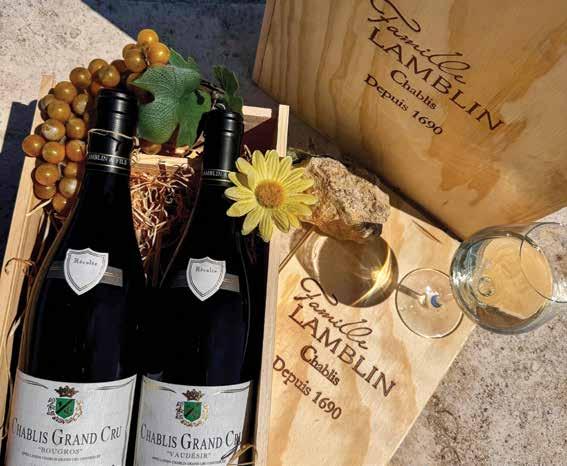
CHABLIS GRAND CRU, VAUDÉSIR, AOC CHABLIS GRAND CRU, 2024
Chardonnay
Pale lemon hue. Majestic, towering nose highlighting the enormous potential quality in this part of the world and proving the wisdom of those who planted vineyards here many centuries ago. Notes of honey, hay, lemon pith, pink grapefruit, wet stone, cinnamon, ginger, brioche, nectarine on the nose; this just about falls off the back of the palate, such is its length and unctuousness. Piercing acidity helps keep it in balance, and there is a wealth of fruit that will continue to develop in complexity. The finish is lingering, driven equally by stone and citrus fruit but supported by subtle oak. A wine to sip and savour for many years to come. 2028-2035 –mp
CHABLIS GRAND CRU, BOUGROS, AOC CHABLIS GRAND CRU, 2024
Chardonnay
Pale lemon hue. Sweet aniseed and honeysuckle aromas; bright yellow midsummer fruits (peach and nectarine). Considerable charm but retains the classicism of its origins. Almost opulent this year, a very generous Bougros with sandalwood and fenugreek spices underscoring the resource hidden within the bright, taut peach and nectarine fruits. It has enough stony drive to age, and the balance remains brisk and sustained. 2026-2033 – aj
5797
DID YOU KNOW? CHABLIS GRAND CRU IS THE PINNACLE OF CHABLIS WINE, PRODUCED FROM CHARDONNAY ON A SINGLE, SOUTH-FACING HILL ON THE RIGHT BANK OF THE SEREIN RIVER. IT COMPRISES SEVEN CLIMATS (SPECIFIC VINEYARD SITE) – BLANCHOT, BOUGROS, GRENOUILLES, LES CLOS, PREUSES, VALMUR, AND VAUDÉSIR.
Lemon pith, pink grapefruit, wet stone,
Alaskan king crab with yuzu
[0.50]
Atlantic turbot with beurre citron and artichoke barigoule
CHABLIS GRAND CRU CASE - 1 BOTTLE EACH: VAUDÉSIR AND BOUGROS (WOOD CASE)
$ 185 $ 370
Chablis’ Grand Cru vineyards occupy a single continuous stretch of vineyard (it’s just one appellation, not seven) on the warmer Right Bank of the Serein, looking across benignly to the little town of Chablis itself. Vaudésir is an intriguing Grand Cru climat (traditional site): a heat-trap side valley which combines ripeness with stony drive. It’s considered second only to Le Clos. Bougros, by contrast, is a bipartite vineyard with a steep southern section and a plateau-like north: expect a softer and more balanced style. Both wines are barrel-fermented in older wood to add discreet creamy texture without overt vanilla.
NEW Fine-tuned since the Middle Ages by countless generations of patient, Cistercian monks, one is hard-pressed to get bored with Burgundy, be that its history, its food or its wines. The limestone escarpment of the Cote-d’Or has enchanted everyone since Charlemagne and there is a lifetime’s study in its geology, topography and in the fiendishly complicated lineage of its producers.
5814
5808
DOMAINE BONNARDOT BEAUNE PREMIER CRU BELISSAND, AOP, 2023
$ 125 $ 750
Pale ruby hue. This leaps out of the glass like a ballet dancer, with twirling redcurrant, strawberry, raspberry, blackberry, sweet cherry, liquorice, vanilla, clove, cinnamon and cedar. I love this gracious, old-fashioned style of Burgundy, with the emphasis rightly on fruit rather than oak. The finish is a work of art, with structure and concentration in spades. It will age well for a decade. 2026-2036– mp

DOMAINE LA JOLIVODE POMMARD AOC, EARL CHRISTIAN ET PASCAL MENAUT, 2022
$ 125 $ 750

Medium purple hue. This has a hedonistic nose of ripe plum, blackberry, raspberry, griottes, mulberry, wood smoke, liquorice and clove. The palate positively explodes with an impressive display of red and black fruit, including cherry, plum and berry. Oak adds secondary notes of cedar and vanilla, and there are tertiary notes of tobacco, cooked plum and prune. The finish is exceptional, its beautifully integrated tannins and streak of acidity promising a long life. An unmissable glass of red Burgundy, and fabulous value to boot. 2026-2032– mp
14.5%
Roasted squab with black trumpet mushrooms and pinot reduction

5802
5803
DOMAINE DÉSERTAUX-FERRAND
NUITS-SAINT-GEORGES PREMIER
CRU LES CHABOEUFS, AOP, 2023
Pinot Noir
Pronounced, opulent nose with obvious oak contributing wood smoke, vanilla, coffee and caramel. Fruit comes via blackberry and black cherry. The palate is wellequipped to absorb this much oak, driving confidently towards a finish characterized by lush, concentrated cherry alongside anticipated wood nuances. 2026-2028– mp
Wood smoke, coffee, blackberry
Black cherry, vanilla, caramel
Slow-cooked lamb shoulder with rosemary jus and black garlic purée
DOMAINE DÉSERTAUX-FERRAND
NUITS-SAINT-GEORGES PREMIER
CRU LES SAINTS-GEORGES, AOP, 2023
Pinot Noir
Deep garnet hue. Chunky raspberry and plum fruits, with ample rough-cut exuberance and aromatic energy. This is mouthfilling, spicy and sweet-toned, with ample ripeness, power and drive. Look out for chocolate and Havana-leaf notes on the finish. The tannins are generous (though not foreboding) and will marshal the fruit successfully through maturity. 2027-2034–aj
Dark plum, raspberry, caramel
Black cherry, chocolate, Havana-leaf
Charcoal-grilled beef ribeye with bone marrow butter and wild mushroom farro
Pommard commands a healthy respect for its aromatically enchanting wines that offer perhaps less grippy tannins and more pleasure than many communes. There is Grand Cru material here (although the town has previously declined the offer). With or without the Grand Cru bells and whistles, this beguiling example from Christian & Pascal Menaut is gloriously robust and vividly aromatic. Up the road, Beaune (where there is a higher proportion of sand in the soils) offers a little more black fruit together with, silky, feline tannins. Both, however, appear positively approachable next to the beauroy brawny, tannic majesty of Nuits-SaintGeorges. The differences are quite extraordinary given there is no more than 10 kilometres between them. But that, as we’ve said many times, is exactly what makes Burgundy so deeply desirable. Pinot Noir – so often hard to please – really is in its element here.

THIS EXQUISITE WINE WILL ARRIVE ELEGANTLY TISSUEWRAPPED IN A STUNNING WOODEN CASE.
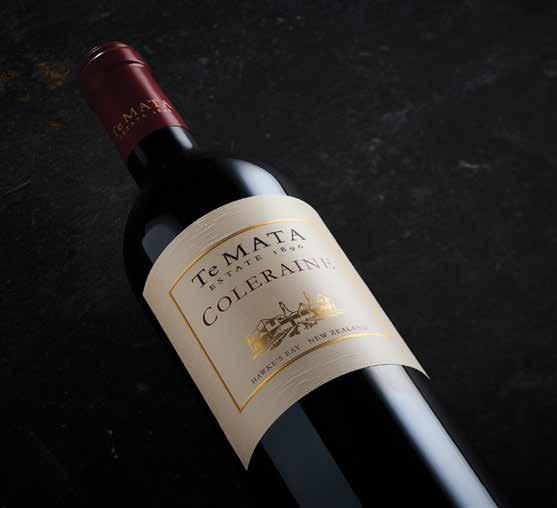
5766
The 2023 vintage in Hawke's Bay, New Zealand’s leading region for structured red wines, broke multiple records: the longest-growing season ever; the lowest yielding, with the smallest berries; the wettest – and the second hottest; the season with the longest harvest and the most expensive labour costs. It was, though, an ‘oceanic’ vintage which suited Cabernet much better than other red varieties … especially in the well-drained coastal vineyards of the Havelock Hills, which is where the prized Coleraine comes into being. The blend this year is 80 per cent Cabernet (from 24 different plots), with 15 per cent Merlot and a seasoning of Cabernet Franc, given 17 months in mainly new French oak barrels. This grandee is often considered ‘New Zealand’s Grange’, though its style is necessarily different: more svelte, more elegant. It ages gratifyingly slowly; even early vintages (it was first made in 1982) remain in fine fettle. $ 187 $ 1122
TE MATA ESTATE COLERAINE, HAWKE'S BAY, 2023 (TISSUEWRAPPED IN WOODEN BOX)
In 2015, three of his wines from the 2013 vintage received a rating of 100 points from The Wine Advocate; thus his nickname, “Mr. 300 points” (Herr 300 Punkte in German). We are pleased to announce that Opimian has secured a small allocation of these outstanding wines from this brilliant winemaker. Don’t miss this opportunity to get your hands on these top-scoring wines, as they usually sell out in record time!
Cabernet Sauvignon, Merlot,
Only at Opimian.ca beginning February 27.
LIMITED TIME – LIMITED QUANTITIES – WEB ONLY
Dark purple hue. Light, graceful aromas of fresh, almost green-toned fruit and svelte spices. Very balanced and harmonious after its cellar cossetting. As the aromas suggested, this is a wine of poise, refinement and almost European classicism. It has elegant, carefully sculpted edges, firm though understated tannins, and the acids are deeply etched into the cool, nearleafy blackcurrant fruit on which the blend is built. Don't expect opulence -- but prepare to be impressed, nonetheless. 2026-2032–aj






